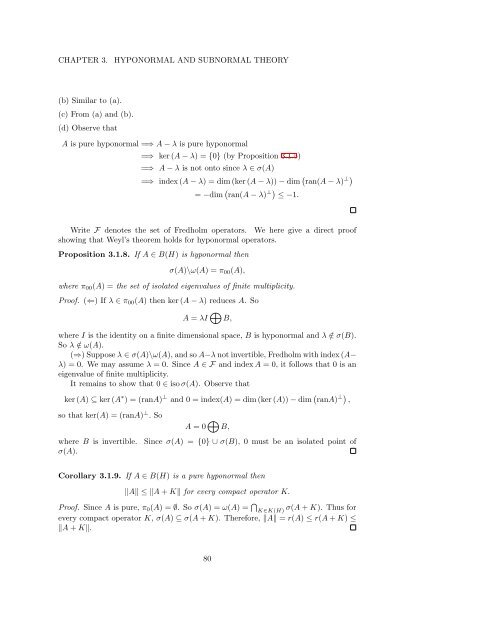Woo Young Lee Lecture Notes on Operator Theory
Woo Young Lee Lecture Notes on Operator Theory
Woo Young Lee Lecture Notes on Operator Theory
Create successful ePaper yourself
Turn your PDF publications into a flip-book with our unique Google optimized e-Paper software.
CHAPTER 3.<br />
HYPONORMAL AND SUBNORMAL THEORY<br />
(b) Similar to (a).<br />
(c) From (a) and (b).<br />
(d) Observe that<br />
A is pure hyp<strong>on</strong>ormal =⇒ A − λ is pure hyp<strong>on</strong>ormal<br />
=⇒ ker (A − λ) = {0} (by Propositi<strong>on</strong> 3.1.5)<br />
=⇒ A − λ is not <strong>on</strong>to since λ ∈ σ(A)<br />
=⇒ index (A − λ) = dim (ker (A − λ)) − dim ( ran(A − λ) ⊥)<br />
= −dim ( ran(A − λ) ⊥) ≤ −1.<br />
Write F denotes the set of Fredholm operators. We here give a direct proof<br />
showing that Weyl’s theorem holds for hyp<strong>on</strong>ormal operators.<br />
Propositi<strong>on</strong> 3.1.8. If A ∈ B(H) is hyp<strong>on</strong>ormal then<br />
σ(A)\ω(A) = π 00 (A),<br />
where π 00 (A) = the set of isolated eigenvalues of finite multiplicity.<br />
Proof. (⇐) If λ ∈ π 00 (A) then ker (A − λ) reduces A. So<br />
A = λI ⊕ B,<br />
where I is the identity <strong>on</strong> a finite dimensi<strong>on</strong>al space, B is hyp<strong>on</strong>ormal and λ /∈ σ(B).<br />
So λ /∈ ω(A).<br />
(⇒) Suppose λ ∈ σ(A)\ω(A), and so A−λ not invertible, Fredholm with index (A−<br />
λ) = 0. We may assume λ = 0. Since A ∈ F and index A = 0, it follows that 0 is an<br />
eigenvalue of finite multiplicity.<br />
It remains to show that 0 ∈ iso σ(A). Observe that<br />
ker (A) ⊆ ker (A ∗ ) = (ranA) ⊥ and 0 = index(A) = dim (ker (A)) − dim ( ranA) ⊥) ,<br />
so that ker(A) = (ranA) ⊥ . So<br />
where B is invertible.<br />
σ(A).<br />
A = 0 ⊕ B,<br />
Since σ(A) = {0} ∪ σ(B), 0 must be an isolated point of<br />
Corollary 3.1.9. If A ∈ B(H) is a pure hyp<strong>on</strong>ormal then<br />
∥A∥ ≤ ∥A + K∥ for every compact operator K.<br />
Proof. Since A is pure, π 0 (A) = ∅. So σ(A) = ω(A) = ∩ K∈K(H)<br />
σ(A + K). Thus for<br />
every compact operator K, σ(A) ⊆ σ(A + K). Therefore, ∥A∥ = r(A) ≤ r(A + K) ≤<br />
∥A + K∥.<br />
80













